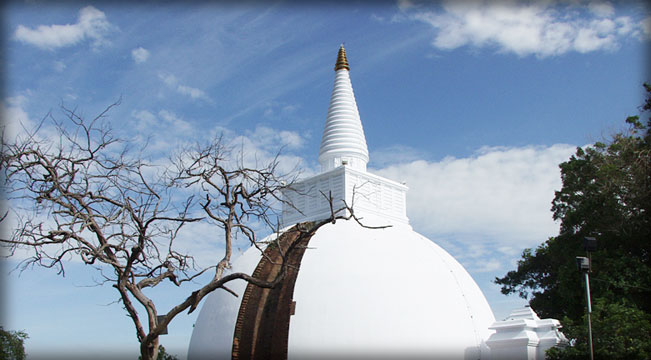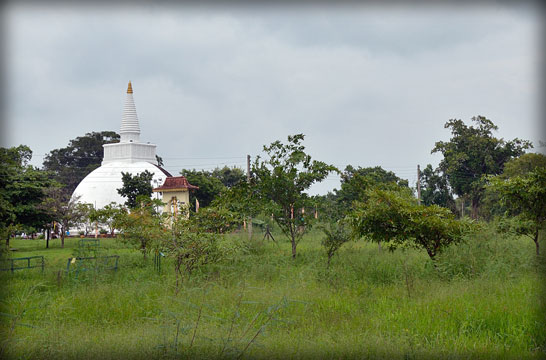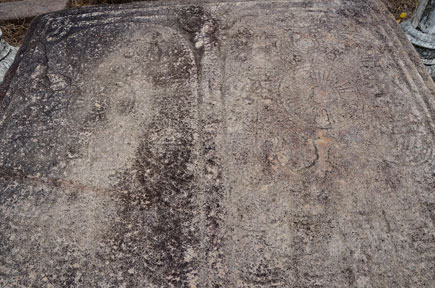|
Somavathiya
Chaitya:
Place of mystery and miracles
Story and pictures by Mahil Wijesinghe
 We are on our way to Somavathiya Chaitya. From the Polonnaruwa town
we pass through the Muslim dominated town of Sungawila, and take the
road that was once a bumpy, unpaved track that loosely connected a
number of dilapidated bridges. This time around, the road is carpeted
and the bridges are new. Traversing this stretch is conveniently smooth. We are on our way to Somavathiya Chaitya. From the Polonnaruwa town
we pass through the Muslim dominated town of Sungawila, and take the
road that was once a bumpy, unpaved track that loosely connected a
number of dilapidated bridges. This time around, the road is carpeted
and the bridges are new. Traversing this stretch is conveniently smooth.
We had aimed to reach Somavathiya early in the day, but got
sidetracked by the various sites en-route and arrived somewhat late in
the morning. There were already several buses that had brought pilgrims
from many parts of the country. Some of them were preparing their
mid-day meal under the trees.
Miracle
Known as a place of mysterious sights and miracle rays of light, the
Somavathiya Chaitya lies 50 kilometres north-east of Polonnaruwa, in the
jungles of Somavathiya Wildlife Sanctuary. Today it is deemed as being
part of the Wasgamuwa Strict Natural Reserve, the floodplains of the
Mahaweli River and Trikonamadu Natural Reserve.
The Somavathiya Chaitya was constructed by order of King Kavantissa
of Ruhuna on behalf of his sister Princess Somadevi, who was the wife of
King Giri Abhaya, the sub ruler of the region. Princess Somadevi had a
great desire to have a relic enshrined Chaitya for the veneration of
people. Both her husband and brother helped her fulfil her mission and
found a place called Somapura, where Arahat Mahinda was said to have
resided with 5,000 monks, to build the Chaitya.
|

The majestic Somavathiya Chaitya seen through a shrub jungle |
Constructed in second Century BC, the relic chamber of the
Somavathiya Chaitya is believed to have the sacred Right Tooth Relic of
the Buddha enshrined within. The Brahmi inscriptions detailing the
history of the Chaitya, which dates back to the second Century BC,
attests to the period in which it was originally constructed, although
it had been renovated by several subsequent rulers.
It is said that Somavathiya Chaitya was constructed in the
floodplains of the Mahaweli River. Even today the Somavathie Temple is
located to the west of the Mahaweli River, in Polonnaruwa District.
Its position is very different from what is described in the ancient
chronicles, which says that the Stupa is on the east embankment of the
river. However, this change in location is thought to be a result of the
river changing its course over time. During the rainy season, it is well
known that the Somavathiya Chaitya and surrounding areas are constantly
inundated due to flooding. It is also apparent that the current road too
lies on the river bed of the ancient Mahaweli River.
Historical chronicles records that at a place called Kalinga, the
Mahaweli River divided into two, carrying water along two channels.
According to tradition the right bank channel was 50 miles long, taking
its water all the way almost up to Verugal Aru, built by King Datusena.
The left bank channel also called Kalinga Ela, took its water to the
borders of Trincomalee.
Unfortunately, these channels had reportedly failed suddenly, causing
the destruction of the channels systems and bringing famine to the
population to the Mahaweli delta. It is believed a natural disaster like
earthquake could have upset the entire Kalinga channel system.
Inscription
|

One of the four flower altars within the Chaitya. |
There is a stone inscription near the Somavathiya Chaitya, which has
been found to be around 2,000 years old. This inscription mentions a
crossing point or ferry, which was on the old course indicating that the
river changed course within the 2,000 years.
With the Chola and Pandyan invasions and the breakdown of the
Polonnaruwa civilization, Somavathiya Chaitya went into ruin and was
enveloped by the jungle. It was resurrected in 1947 by a Buddhist
Bhikkhu named Ven. Sirimalwatte Piyaratana, who trekked through the
jungle for many miles to discover the ruins of the Chaitya, having seen
a miraculous light emanating from the jungle in the sky.
Known as the enshrine of the 'Right Tooth Relic of Buddha', the
Somavathiya Chaitya remained unknown and deserted for over a thousand of
years in the thick jungle of Eastern Sri Lanka until it was discovered
in 1947. With the discovery of the Chaitya, archaeologists from the
Department of Archaeology began excavations and restoration works of
bringing the Chaitya to its original condition.
There is no doubt about the antiquity of the site and the ancient
stone inscription on the site reflect to the reign of King Kavantissa
(44-22 BC) and is characterised by features from that era which included
undecorated balustrades, four moonstones and surrounding brick walls.
Cleft
|

A deep cleft seen in the Chaitya to expose the ancient brick
work. |
|

The ruined stone pillars lies on the ground in the vicinity
of the Chaitya. |
A deep cleft has been left visible in the Stupa exposing the ancient
bricks of the original Chaitya. What is also unique about the
Somavathiya Chaitya is that the altars are within the Stupa itself.
Here, devotees have to climb the steps in single file to reach the small
enclosure that accommodate about four people. Scattered in the vicinity
of the Chaitya are a number of ruins, amongst them stone inscriptions,
fallen and half buried stone pillars and stone carved Siripathul Gal in
the shrub jungle.
Being located within the Somavathiya Wildlife Sanctuary, large herds
of elephant roam the surrounding wilderness of the Somavathiya Chaitya,
making it one of the best places to spot herds of elephant.
During our stay, we saw herds of elephants grazing in the jungle
close to the Chaitya and also a lone wild elephant standing near the
electric fence, perhaps begging for food from visitors. However, the
entire Chaitya premises is covered with an electric fence preventing
wild elephants entering the sacred area. |

